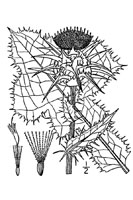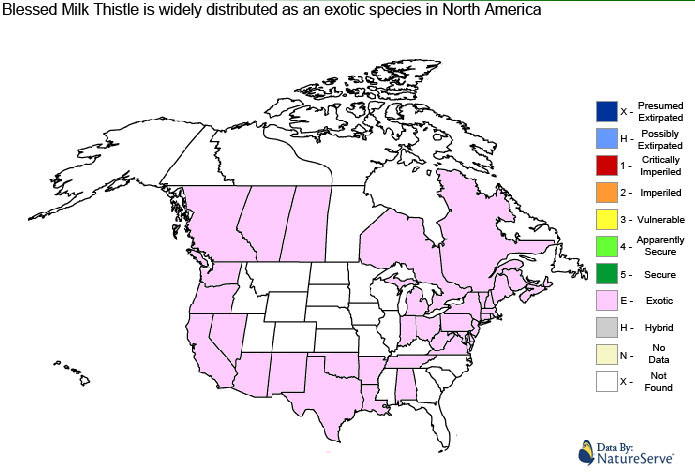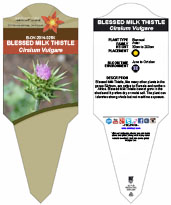

| Plant Name | Blessed Milk Thistle | |
| Scientific Name | Silybum marianum | |
| Family | Aster | |
| Plant Type | Biannual | |
| Start of Blooming Season | June | |
| End of Blooming Season | August |

| Soil Conditions | |
| Soil Moisture | |
| Sunlight | |
| Notes: |

Blessed Milk Thistle can grow from 30cm to 200cm tall with an overall conical plant shape. The stem of the blessed milk thistle is grooved and more or less cotton like with the largest specimens; The stem will become hollow. The leaves of the blessed milk thistle are oblong to lanceolate. They are either lobate or pinnate, with spiny edges. They are hairless, shiny green, with milk-white veins that when broken produce a milky white sap. The flower heads are 4cm to 12 cm long and wide and are red to purple in colour. Blessed Milk Thistle is in bloom from June to August in the Northern Hemisphere or December to February in the Southern Hemisphere. The flowers are hermaphrodite (have both male and female organs) and are pollinated by Bees. The seeds of the blessed milk thistle are black with a simple long white pappus surrounded by a yellow basal ring.


The following health hazards should be noted when handling blessed milk thistle:
 |
SHARP HAZARD Thistles contain small sharp thorns which can be painful if incorrectly handled. |
 |
POSSIBLE TOXICITY When grown on nitrogen rich soils, especially those that have been fed with chemical fertilizers, this plant can concentrate nitrates in the leaves. Nitrates are implicated in stomach cancers. Diabetics should monitor blood glucose when using. Possible headaches, nausea, irritability and minor gastrointestinal upset can occur after ingesting. |
 |
ENVIRONMENTAL HAZARD Because of potassium nitrate content, the plant has been found to be toxic to cattle and sheep. When potassium nitrate is eaten by ruminants, the bacteria in an animal's stomach break the chemical down, producing a nitrite ion. Nitrite ion then combines with hemoglobin to produce methaemoglobin, blocking the transport of oxygen. The result is a form of oxygen deprivation. |

 |
-Click here- or on the thumbnail image to see an artist rendering, from The United States Department of Agriculture, of blessed milk thistle. (This image will open in a new browser tab) |

 |
-Click here- or on the thumbnail image to see a magnified view, from The Canadian Food Inspection Agency, of the seeds created by blessed milk thistle for propagation. (This image will open in a new browser tab) |

Blessed Milk Thistle can be referenced in certain current and historical texts under the following three names:
Blessed Milk Thistle can be translated into the following select languages:
| Arabic | المبارك الحليب الشوك | Bulgarian | Блажен млякомагарешки бодил | Chinese (Sim) | 祝福奶蓟 |
| Croatian | Blago mlijeko čičak | Czech | požehnané Ostropestřec mariánský | Danish | velsignede mælk tidsel |
| Dutch | Gezegend melkdistel | Esperanto | benitan lakto prunelon | Estonian | õnnistatud piima ohakas |
| Finnish | French | chardon béni | German | Mariendistel | |
| Greek | Ευλογημένος γαϊδουράγκαθο | Hebrew | גדילן מצויה לברכה | Hungarian | áldott bogáncs |
| Italian | Beato latte cardo | Japanese | 祝福オオアザミ | Korean | 축복 엉겅퀴 |
| Low Saxon | Lithuanian | palaimintosios pieno usnis | Norwegian | velsignet melk tistel | |
| Persian | خوشا به شیر خار | Polish | Błogosławiony Ostropest | Portuguese | cardo de leite abençoadas |
| Romanian | Ferice de lapte ciulin | Russian | благословенные Расторопша | Slovak | požehnanej Pestrec mariánsky |
| Spanish | Bendita leche cardo | Swedish | välsignade mjölktistel | Tagalog | tistle mapalad gatas |
| Turkish | Mübarek süt devedikeni | Ukrainian | благословенні Розторопша | Vietnamese | cây kế sữa phúc |

| The information provided in this conservation assessment has been provided by the Natureserve Database in conjuction with various federal, provincial, state, county, district, regional, and municipal governments as well as public and private conservation authorities. Information in this section is accurate from the last time this article was updated. | |
 |
Blessed Milk Thistle has no conservation status as it is considered an exotic and or invasive species in North America. |

 |

 |
The MIROFOSS database offers free printable garden tags for personal and non-profit use. These tags can be used to properly identify plant samples in a garden. Click on the tags shown on the the screen or -click here- to download a full size jpeg image for a blessed milk thistle identification tag; which can be printed on paper or used with a plastic laser printer. |
 |
What's this? What can I do with it? |

| Description | Rose, Francis (1981). The Wild Flower Key. Frederick Warne. pp. 388–9. ISBN 0-7232-2419-6. |
| Folklore | Hogan, Fawn S.; Krishnegowda, Naveen K.; Mikhailova, Margarita; Kahlenberg, Morton S. (2007). "Flavonoid, Silibinin, Inhibits Proliferation and Promotes Cell-Cycle Arrest of Human Colon Cancer". Journal of Surgical Research 143 (1): 58–65. |
| Biology | Kroll, D. J.; Shaw, H. S.; Oberlies, N. H. (2007). "Milk Thistle Nomenclature: Why It Matters in Cancer Research and Pharmacokinetic Studies". Integrative Cancer Therapies 6 (2): 110–9. |
| Image Rendering | USDA-NRCS PLANTS Database / USDA NRCS. Wetland flora: Field office illustrated guide to plant species. USDA Natural Resources Conservation Service. |
| Environment | National Audubon Society. Field Guide To Wildflowers (Eastern Region): Alfred A. Knopf. pp 415-420 ISBN 0-375-40232-2 |
| Physical Identification | National Audubon Society. Field Guide To Wildflowers (Eastern Region): Alfred A. Knopf. pp 415-420 ISBN 0-375-40232-2 |
| February 02, 2015 | The last time this page was updated |
| ©2021 MIROFOSS™ Foundation | |
 |